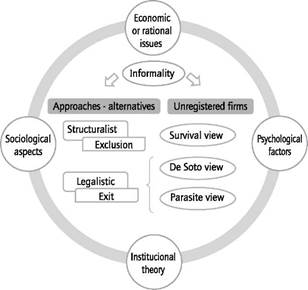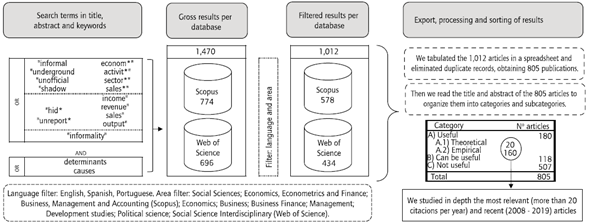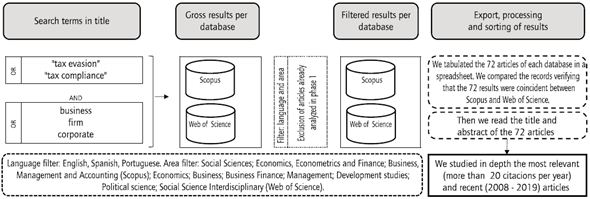Introduction
Unofficial economic activities -those conducted by unregistered or registered firms but hidden from taxation- in many emerging countries account for between a third and a half of total economic activities. This share declines sharply as the economy develops (La-Porta & Shleifer, 2008). Throughout the world, two-thirds of all enterprises are unregistered at their start-up (Autio & Fu, 2015) and over half of all current enterprises operate unregistered (Acs et al., 2013).
The informal economy produces several consequences, making it a relevant issue (Putniņš & Sauka, 2015). In the macroeconomic sphere, the informal sector can create a vicious circle: individuals or companies go underground to evade taxes and social security contributions, eroding tax bases and reducing tax revenue. This results in a decrease in the quality and quantity of public goods and available services that encourages increases in tax rates on the formal sector, with the consequent generation of greater incentives to participate in the informal economy. Second, unreported activities can hamper economic growth by diverting resources from productive uses to unproductive ones. In addition, the informal economy distorts official statistics, hindering the task of public-policy makers (Putniņš & Sauka, 2015; Schneider & Enste, 2000).
At the microeconomic level, although hidden activities generate additional revenue for companies, various disadvantages arise from this issue. The existence of non-reported sales restricts the ability of firms to obtain debt or capital financing since potential creditors or investors cannot verify real (hidden) cash flows, thus hindering the entity's management process and causing difficulties in results determination (reported and non-reported information is required). It also causes inconveniences in inventory management and loss of control over resources, in general, facilitating potential theft and fraud (Putniņš & Sauka, 2015).
Considering the above, this article focuses on firm informality, that is, businesses that are not registered and formal companies that report a lower level of revenue to reduce their tax burden (La-Porta & Shleifer, 2008). In particular, this paper seeks to identify the factors that motivate entrepreneurs or companies to operate totally within informality, as well as the drivers behind revenue underreporting among formal companies. Within the firm informality idea, corporate tax evasion is included, since many formally registered firms evade taxes by underreporting their revenues, which implies partial compliance with tax regulations (Slemrod & Weber, 2012; Ulyssea, 2020). Hence, this article does not study informality in the labor market. In sum, in this work we use the words "informality," "informal economy," and "informal sector" as alternative expressions to refer to the broad definition of the phenomenon;1 we also use firm/business/corporate informality as synonyms in reference to the narrow concept, which is the object of analysis of the article.
In order to identify firm informality determinants we rely on a systematic review of the theoretical and empirical literature available in Scopus and Web of Science databases, following the review protocol described in the appendix section. Considering that firm informality can be addressed both in informal economy analysis and in tax evasion research studies, we decided to perform a two-stage review to cover both possibilities. After reading the title and abstract of all the articles obtained from the first step of the process, we selected for an in-depth analysis those that were consistent with the object of study (firm informality), the most relevant (number of citations), and the most recent contributions.
Our work presents several contributions. First, the article studies the theoretical pillars linked to informality, including different approaches (structuralist, legalistic) and issues about various theories, as institutional and rational choice, as well as psychological and sociological aspects. Second, unlike previous studies that make a general approach to the informal economy, this paper focuses exclusively on the determinants of business informality. In this way, it emphasizes the study of the reasons that encourage corporate tax evasion -over personal tax evasion (Torgler, 2002)- and explicitly excludes the analysis of unregistered work (labor market informality) causes. Specifically, the article outlines the determinants of business informality by summarizing an important set of studies with different methodological approaches (macro and microeconomic) in different contexts (developed, emerging and transition economies) and periods (1983-2018). Finally, the study proposes an integrative model of business informality determinants, organizing them in groups and theoretical constructs.
Besides this introductory section, the remainder of the article is organized as follows. The next section exposes frameworks of analysis, theoretical basis, and conceptual models that support the hidden activity phenomenon. Afterwards, we will present the empirical background by classifying previous studies according to their methodological approach and describing firm informality determinants and their link with informality, according to the empirical evidence addressed. Encompassing theoretical and empirical points, the section that follows proposes an integral theoretical model of firm informality determinants. The last section concludes by discussing the academic and practical contributions of this work.
Informality: Theoretical framework
Framework of analysis and theoretical basis
The informal sector can be analyzed from two frameworks that can be seen as complementary. On the one hand, the structuralist2 dimension (Jiménez-Restrepo, 2012), exclusion perspective (Perry et al., 2007) or survival view (La-Porta and Shleifer 2008, 2014), proposes that individuals and companies cannot formally operate because they are too unproductive to ever become formal, even without entry costs. These are small productive units that operate under the motivation of subsistence and the supply of low-quality jobs, in which labor-intensive and low-wage production techniques are abundant. These are entrepreneurs with low human capital, who are only able to survive in the informal sector because they avoid taxes and regulations (Harris & Todaro, 1970; Lewis, 1954; Rauch, 1991). According to this first dimension, the economic and productive structure of a country and the survival instinct of people are what determine the existence of the informal sector.
On the other hand, for the legalistic3 dimension (Jiménez-Restrepo, 2012), or exit perspective (Perry et al., 2007), the informal sector is shaped by firms and persons that voluntarily decide to operate under the umbrella of informality as a result of a cost-benefit analysis (rational choice). Unregistered firms included in this approach can be classified through the Parasite view or De Soto's view (La-Porta & Shleifer 2008, 2014). The first case involves firms that are productive enough to enter the formal sector but choose not to do so because it is more profitable to operate in the informal sector (Farrell, 2004). De Soto's view corresponds to potentially productive informal companies that operate informally because of high entry costs. If these were removed, companies would enter the formal sector and improve their performance, since they would no longer have size constraints imposed by informality (De-Soto et al., 1987).
Several authors recognize the importance of analyzing the informal sector through the use of mixed models (Jiménez-Restrepo, 2012; Ordóñez-Castaño & Sanabria-Domínguez, 2014; Ortiz & Uribe, 2004) or holistic approaches (Bertranou & Casanova, 2014; Ludmer, 2019).
Sometimes, the informal economy is empirically studied using a single theoretical argument, for example, ideas from the neoclassical stream or institutional theory, or with assertion from some disciplines of the social sciences (sociology, psychology). The neoclassical theory establishes utility maximization based on objective probabilities, institutionalists examine the role of norms, sociologists emphasize the importance of demographic factors, and psychologists consider the intrinsic motivations of agents (Schneider & Enste, 2013). However, in stark contrast to traditional debates that adopt one or another theoretical perspective, recent research emphasizes the need for a comprehensive vision of the conceptual framework to fully understand the prevalence of the informal sector (Williams & Liu, 2019). Figure 1 presents a summary of the relation among the different theoretical and empirical approaches on the subject. The subsections below present different theories that have been used to explain the existence of informal sector: economics, institutional theory, sociology, and psychology.
Economic foundations
From a classic economic perspective, individuals are rational agents (homo economicus) who weigh the costs and benefits when they consider breaking the law. In that sense, their decision to participate partially or completely in the informal economy is a choice under uncertainty. This implies a compensation between the benefits of operating in the informal sector if their activities are not discovered, and the inherent losses if they are detected and penalized (Allingham & Sandmo, 1972; Schneider, 2016). If it is assumed that the behavior of economic agents fits the Von Neumann-Morgenstern axioms under uncertainty, they select their level of income to report at the point that they maximize the expected utility function (Arrow, 1965, 1971; Pratt, 1964; Von-Neumann & Morgenstern, 1944). This expected utility is calculated considering factors such as tax burden, regulations, fines and the probability of detection, among others (Schneider & Enste, 2013).
In this sense, individuals or entrepreneurs evaluate the expected utility of the revenue reported level by comparing the benefits of evasion in the form of tax savings against the probability and expected sanctions in case they are discovered. The higher the probability of being caught or the more serious the consequences, the less attractive it is to evade taxes. Therefore, the decision of underreporting income (participate in the informal economy) is affected by tax rates, detection probability, size and type of sanctions, and attitudes of entrepreneurs towards risk-taking (Putniņš & Sauka 2015).
Institutional theory
The institutional theory seeks to understand individuals and organizations in the institutional context they belong to. Institutions are the rules of the game in a society or, more formally, the restrictions created in order to shape human interaction. Formal institutions refer to laws, regulations, and their supporting instruments (enforcement agencies, regulatory bodies, etc.), while informal institutions include norms, values, and beliefs that define socially acceptable behaviors (North, 1990).
We recognize three schools that analyze the relationship between informal economy and institutional theory. The first one identifies the relationship between the quality of formal institutions and informality. In this case, the studies highlight the influence of the restrictions imposed by formal institutions on the informal economy, examining the existence of excessive regulations, high taxes, corruption, weak or inappropriate legal systems, and contract compliance regimes. This shows greater informality in coutries with greater intensity of regulations, worse legal environment, and poor protection of property rights. This line of thinking, therefore, gives little relevance to the impact of informal institutions (Williams & Horodnic, 2016).
The second school of thought investigates how the relationship between formal and informal institutions influences the level of informality. Considering that informal institutions may be complementary or substitutes for formal institutions (if the rules of the former are compatible or not with the latter), the informal economy exists due to the inconsistency between what formal and informal institutions define as legitimate (Webb et al., 2009). When there is symmetry between formal and informal institutions, the informal sector is small because the socially shared norms, values and beliefs of informal institutions are aligned with the codified laws and regulations of formal institutions. However, when there is asymmetry between formal and informal institutions, the result is the emergence of informal economic practices that, although socially legitimate in terms of informal institutions, are illegal in terms of formal rules (Webb et al., 2009; Williams & Horodnic, 2016). In this sense, informal economy contains activities that recognize and take advantage of opportunities that occur outside formal institutional boundaries, but within the limits of informal institutions.
Finally, the third school of thought considers that informal economy is the result of imperfections in the application of the regulations of formal institutions (Webb et al., 2000). Such imperfections can be of different types. One of them arises because of objectives and cost-benefit analysis: the application of regulations is usually concentrated in companies of certain characteristics (sector, size, legal form). Other imperfections emerge due to the application methods that execution agents have available. In such cases, informal economy entrepreneurs benefit by exploiting opportunities that exceed such application methods. In third place, personal motivations and negligence of formal institutional agents can further undermine efforts to control the informal economy.
Sociological aspects
The sociological perspective, based on the concept of homo sociologicus, highlights the importance of demographic data and general personal characteristics to explain the behavior of participants in the informal economy. In this sense, attributes such as age, gender, marital status, education level, income level, household size, and financial situation, among others, are determinants in the propensity to participate in the informal sector (Schneider & Enste, 2013).
The sociological variables contribute to the analysis of the behavior of illicit workers, which can be characterized by specific descriptive criteria (e.g., age, occupation, number of children) and employed to define types. Thus, illicit workers can be divided according to their motivation to engage in shadow economic activities. Besides the individual attitudes, the structure of opportunities is an important factor influencing the supply and demand of illicit work (Schneider & Enste, 2013).
Psychological factors
In turn, the psychological approach recognizes the limitations of Allingham and Sandmo (1972) traditional model (essentially its simplicity and its focus only on economic factors) and proposes the inclusion of other determinants of tax evasion, such as moral issues, perceived justice of the tax system, and judgment regarding government performance (Andreoni et al., 1998).
According to the psychological perspective, it is not the objective variables per se (such as tax burden, detection probability, regulatory density, etc.) which induce an increase or decrease of informal economic activities, but rather the subjective perception and evaluation of such attributes. Based on these concepts, several determinants of the informal economy are recognized: feelings of guilt, state activity perceived efficiency, level of satisfaction with the tax system, personal motivations, risk aversion, among others (Schneider & Enste, 2013).
Several of these factors are studied grounded on the intrinsic motivation of individuals to pay taxes, that is, tax morale. The empirical findings indicate that tax morale increases with confidence in government and the judiciary, public services satisfaction, and lower levels of perceived corruption and tax burden (Williams & Horodnic, 2016).
Conceptual models
In this section, we describe some conceptual models that explain informality. These models refer mainly to firm informality -which is the object of analysis in this paper- and therefore are more associated with legalistic dimension (lower panel of the central part in figure 1). Existing informal sector theories assume almost invariably that formality imposes burdens on companies (taxes or costs of compliance with regulatory requirements) and, at the same time, provides benefits (access to quality public goods or services and financing) (Batra et al., 2003; Dabla-Norris et al., 2008; De-Soto et al., 1987; Johnson et al., 2000; La-Porta & Shleifer, 2008). This trade-off determines the decision of the individual economic units with respect to operating in formality or informality (totally or partially) and, ultimately, establishes the relative size of the informal sector (Dabla-Norris et al., 2008).
According to Friedman et al. (2000), two schools of thought explain the motivations of entrepreneurs to operate in the informal sector. The first one identifies high taxes as the main cause: companies that operate totally or partially in the informal sector only seek to retain the totality of the profit generated by the business. The alternative view holds that political and social institutions (bureaucracy, corruption and a weak legal system) are responsible for the increase in informal activity. In this scenario, entrepreneurs have the will to pay reasonable taxes but do not want to tolerate constant, excessive, and arbitrary demands. In this way, the visions raised by Friedman et al. (2000) are grouped into a model that suggests an important contrast between the effects of excessive regulation and corruption, on the one hand, and tax rates, on the other. Regulatory excesses and corruption constitute an unequivocal disincentive to operate in the official sector and are correlated with a greater participation in the unofficial activity. In turn, high tax rates have two potentially compensatory effects: the direct effect increases the incentive to hide the activity, while the indirect effect, through the provision of a better legal environment,4 encourages operation in the official sector. Thus, the model suggests that a higher tax rate does not necessarily correlate with a greater participation in the informal economy.
Johnson et al. (1997) proposed a model for the allocation of resources between the formal and informal sectors focused on the political and institutional determinants of the business response. Model predictions indicate that economies are located in two very different equilibria. Some countries are characterized by low tax burdens, regulation and corruption, relatively high tax revenues, large quantity and quality of public goods, and small unofficial sectors. On the contrary, other nations are located at the opposite extreme, with high taxes, regulation and corruption, low tax income, scarce government goods, and large informal sectors.
Dabla-Norris et al. (2008) proposed a simple analytical model to study the causes that influence the degree of informality of companies based on the work of Rauch (1991). The authors stated that, depending on their individual productivity, each economic agent decides between working as a worker (and receiving a salary) or as an entrepreneur (and obtaining the operating profits) and, in the latter case, decides whether to do so in the formal or informal sector. According to the model, informality is negatively associated with firms' productivity and size: that is, agents of low, medium and high productivity become workers, entrepreneurs in the informal economy, and entrepreneurs in the formal sector, respectively. Then, based on a business production function grounded on workers individual productivity and a fixed level of technology, the benefits of a firm operating informally are derived by comparing the income obtained by formal companies (facing the costs of regulatory compliance) against the results of companies that operate within informality (not complying with regulations, but facing a probability of being discovered and penalized depending on the quality of the institutions). In that sense, the model suggests that the propensity to hide sales is affected by firm productivity, company size, regulation costs, and the quality and efficiency of the legal system.
Ulyssea (2018) studies how informal firms respond to different formalization policies, and their effects at micro level and on overall economic performance. This author develops and estimates -with data from Brazil- an equilibrium model where heterogeneous firms can exploit two margins of informality: (i) not register their business, the extensive margin; and (ii) hire workers "off the books," the intensive margin. He finds that increasing enforcement is highly effective in reducing informality, but reduces welfare in the economy. Moreover, reducing formal sector's entry costs is not as effective in reducing informality but generates welfare gains and leads to greater CDP and wages. Overall, his findings show that informality reductions could be associated to higher CDP or welfare.
In summary, considering that the relevant factors to explain the existence of the informal sector come from different areas, the appropriate models for addressing business informality should recognize the complexity of the phenomenon by incorporating all significant aspects.
Informality: Empirical background
From the systematic literature review carried out, whose protocol is described in the appendix section, we find a large number of documents of which we examine the most relevant (more than 20 citations per year) and recent (2008 onwards, especially those published between 2014 and 2019). In this section we analyze the recovered studies. First, we classify the empirical background according to their methodological approach. Second, we identify and organize the determinants of firm informality.
Although this work focuses on the causes of business informality and the selected search terms point to this particular issue, we also examined a group of articles linked to the broad definition -those that estimate the informal economy by differences between macroeconomic aggregates- considering that they do not allow to disaggregate specific types of informality, but include firm aspects.
Methodological approach by previous studies
The informal economy is a complex phenomenon whose rigorously approach is hampered by its own nature: low availability of relevant information because it involves economic activities and income that are not reported regularly to the authorities (Frey & Pommerehne, 1984; Schneider & Enste, 2000). As with the concept of informal economy, there are discrepancies regarding the procedures designed for its estimation and the use of these for economic analysis and policy development (Buehn & Schneider, 2012). Different empirical approaches have been suggested to estimate the size of the informal sector: indicators (direct and indirect), determinants, and combination of indicators and determinants (Frey & Pommerehne, 1984; Schneider & Enste, 2000).
Direct indicators focus on the behavior of individuals, trying to circumvent their reluctance to provide information, and use surveys or fiscal audits. In turn, the underlying logic of indirect methods is that economic activity, whether reported or hidden, leaves behind observable traces or indicators, such as electricity usage, currency usage, transactions, and official labor force participation rates. In essence, these methods use the observable indicators in various econometric specifications to estimate the true level of economic activity. Subtracting the recorded economic activity from the estimate of the true economic activity gives an estimate of the shadow economy (Frey & Pommerehne, 1984; Putniņš & Sauka, 2015; Schneider & Enste, 2000). Approaches grounded on determinants estimate the size of the informal economy based on the development of the various causes as taxes, regulation, tax morale, government controls, labor market conditions, and structural factors. Finally, the approach that combines indicators and determinants contemplates simultaneously multiple causes and indicators of the phenomenon to be measured based on the statistical theory of unobserved variables (MIMIC: Multiple Indicator Multiple Cause Model) (Schneider, 2016).
Through the systematic literature review, we recognize a large number of papers studying informal economy through different methodologies. Table 1 presents the main empirical background on measurement and determinants of informality organized according to its methodological approach. Macro-economic works (panel A, table 1) use the methods of indirect indicators or combination of indicators and determinants. On the other hand, within the microdata-based literature, there are two trends: one that addresses the phenomenon by comparing formal versus informal companies (panel B, table 1) and another that focuses exclusively on registered firms (panel C, table 1). Research on formal enterprises includes, in turn, studies that examine informality in a comprehensive manner containing unreported sales and wages (for example, Johnson et al., 2000; Putniņš & Sauka, 2015) and others that do so more specifically by analyzing only non-reported revenues (remaining studies in panel C, table 1).
Table 1 Informality: main empirical background organized by approach.
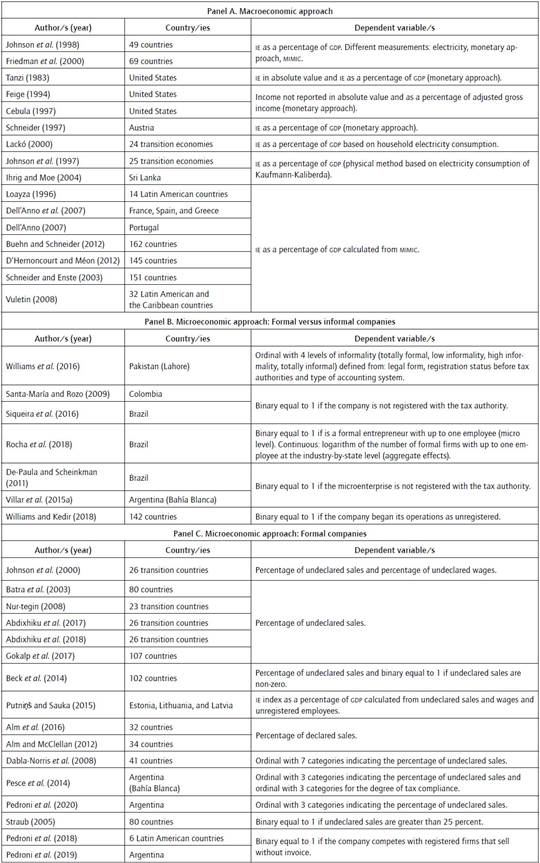
IE: informal economy; CDP: Gross Domestic Product; MIMIC: multiple indicator multiple cause model.
Source: authors based on the literature review.
According to Ulyssea (2020):
This variety of approaches is a natural consequence of the very nature of the phenomenon. On the one hand, informality is a micro phenomenon, as it is the result of individual agents maximizing their payoffs in the economic environment they face. On the other hand, the sheer magnitude of informality and the scale of the policies used to address it make informality a macro phenomenon as well, and one that has deep implications for the economy as a whole. Thus, a complete understanding of informality must encompass both dimensions. (p. 542)
Considering the theoretical approaches described at the beginning of this section, most of the retrieved studies are in line with the legalistic or exit dimension, and include the parasite and the De Soto views' of unregistered firms. This could be an indicator that firm informality is mostly addressed in the literature as a decision or voluntary choice by companies and entrepreneurs (legalistic vision).
Determinants of firm informality
Informality is an endogenous outcome that emerges as the result of firms' optimal behavior given their characteristics and the environment they face (institutions, government policies, and the economic cycle). In order to understand the determinants of informality one must build from the micro -i.e., the behavior of firms- to the macro level (Ulyssea, 2020). Considering the measurement level of determinants (micro or macro variables), we propose a classification of firm informality causes in two large groups: environmental factors and company and entrepreneur's characteristics. Therefore, the suggested organization encompasses the different theoretical basis, conceptual models, and methodological approaches studied above as we describe below.
The determinants grouped into environmental factors (taxes, corruption, regulation and bureaucracy, etc.) are associated with the economic and institutional perspectives, and come from both macro and microeconomic approaches, although they have mostly been studied through macroeconomic variables (i.e. tax revenue/GDP, number of procedures, among others). When environmental determinants are studied at the microeconomic level they are rarely linked to the psychological standpoint (for example, perception of tax and regulation burden or satisfaction with government). In contrast, the influence of company and entrepreneur's characteristics on informality is connected with sociological aspects and can only be analyzed from microdata.
Tables 2 and 3 list firm informality determinants based on the classification suggested and indicates for each factor the type of evidence reported by empirical works identified in the literature review. It is important to mention that, although the determinants identified in these tables receive a generic name, each empirical study approximates them by using different operational definitions.
Table 2 Environmental factors and their link to firm informality according to empirical evidence.
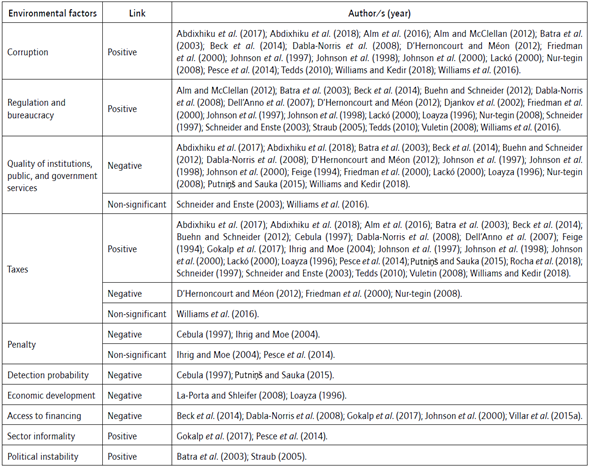
Source: authors based on the literature review.
Table 3 Firm and entrepreneur's characteristics and their link to firm informality according to empirical evidence.
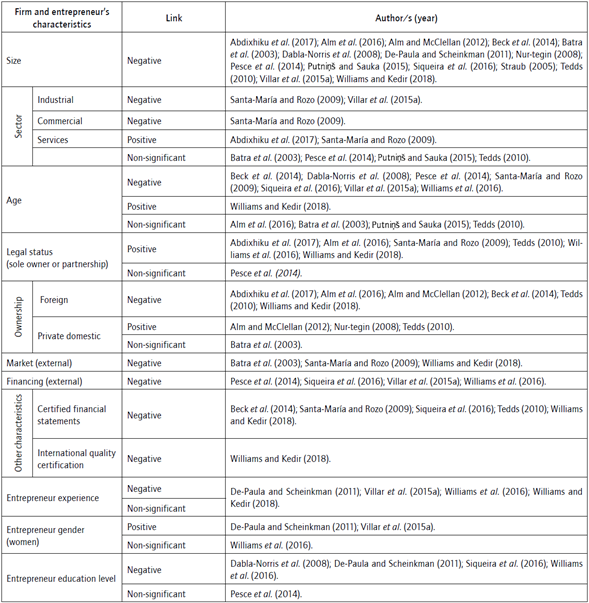
Source: authors based on the literature review.
Environmental factors
Consistent with the formal models, different studies confirm the positive link between corruption and informality, that is, high corruption contexts generate greater incentives to hide economic activities (Friedman et al., 2000). Some authors point out that the causality of the relationship between corruption and the informal economy can also be read in the opposite direction: the greater the informality, the greater the need for bribes payment (Johnson et al., 2000), that is, tax evasion can create additional opportunities for corruption to thrive. However, previous empirical evidence indicates that corruption is a determinant of informality and not vice versa (Alm et al., 2016).
The regulation5 and bureaucracy factor is also widely analyzed in the empirical literature, suggesting that contexts with denser regulations (in terms of the number of laws and requirements, licenses, labor market regulations, trade barriers, etc.) reduce participation in the official economy (Schneider & Enste, 2000). The model by Johnson et al. (1997) predicts that countries with more regulated economies exhibit greater proportions of hidden activities as a percentage of CDP. In addition, these authors concluded that enforcement is the key factor that motivates agents to operate in informality (above the general level of regulation, mostly not applied). Some papers examine this determinant together with corruption (Johnson et al., 2000) while others do so with taxes (Dabla-Norris et al., 2008; Johnson et al., 1997). In particular, research highlights the incidence of labor market regulations (Schneider & Enste, 2000).
The negative relationship between the informal economy and the quality of public, government and institutional services is usually used to explain the downward spiral trend of the informality phenomenon. That is, under the social contract, individuals fulfil certain obligations (such as paying taxes) and the state should provide an appropriate legal framework for the development of economic activities and public services quality. However, given a poor state provision of such elements, agents do not receive sufficient benefits for the fulfilment of their duties as citizens and, therefore, have greater incentives to develop activities informally. This reduces tax revenues and motivates the tax increase on the formal sector, which further undermines the ability of the state to efficiently provide public goods and services (Johnson et al., 1997; Schneider & Enste, 2000).
On the other hand, the empirical literature supports the theoretical predictions regarding the ambiguous relationship between taxes and informality, although most of the studies find a positive link between the tax burden and the size of the informal economy6 (Buehn & Schneider, 2012; Cebula, 1997; Feige, 1994; Johnson et al,, 1997, 1998, 2000; Schneider & Enste, 2013). The negative association between taxes and hidden activity is verified when tax revenues from higher tax rates allow the state to provide a solid legal environment and high-quality public goods by reducing the incentives of companies to migrate to the informal sector (Friedman et al., 2000).
The penalty and the detection probability factors appear to a lesser extent in the empirical studies, although the results are also consistent with the theoretical predictions: the greater the expected penalty and the greater the perceived detection probability, the lesser the incentive to participate in the informal economy (Cebula, 1997; Ihrig & Moe, 2004; Putniņš & Sauka, 2015).
Furthermore, according to La-Porta and Shleifer (2008), the level of economic development -measured in terms of CDP per capita- is one of the most robust determinants of the size of the informal economy. Also, operating totally or partially in the informal sector represents an important opportunity cost for companies because it hinders the possibility of access to financing; hence the negative link with this factor identified by empirical studies (Beck et al., 2014; Dabla-Norris et al., 2008; Johnson et al., 2000).
Finally, the informality level of the environment in which the company operates can generate a greater propensity for other firms in the sector to participate in the informal economy, for example, due to competition and survival issues. Informal sector firms obtain unfair competitive advantages as they offer lower prices than formal companies thanks to reduced operating costs (due to tax evasion and unregistered employment). Moreover, informal companies evade government regulations that may be burdensome due to excessive bureaucracy and corruption of officials. In that sense, formal companies increase their propensity to underreport revenue because they consider tax evasion is an acceptable practice to compensate for unfair competition from unregistered enterprises (Golkap et al., 2017).
The company and entrepreneur's characteristics
Within the second group of determinants (company and entrepreneur's characteristics), firm size is one of the most identified factors by its negative link with the informal economy, that is, formality increases with company size. Empirical findings by previous works also indicate that informality is more recurrent in young companies, especially those from the services sector, organized as sole private proprietorships or partnership, that carry out their economic activities in the domestic market and without external financing. In addition, the propensity to participate in the informal sector is greater when it comes to women entrepreneurs, while it decreases with the level of education and experience of these actors, issues connected with individual productivity considered by the informality analytical models.
The empirical evidence is divergent regarding the impact of the gender of the entrepreneur on informality. Studies that analyze how enterprises start (registered or not) or that examine ownership percentages by gender, find that women are more likely to operate in the informal sector (De-Paula & Scheinkman, 2011; Leino, 2009; Villar et al., 2015a, 2015b). For example, in his research on African micro-firms, Leino (2009) concluded that women entrepreneurs are more likely to operate in the informal sector (the proportion of female property amounts to 38% in non-registered companies and only 25% in formal companies). This pattern of greater female participation in the ownership of informal enterprises is valid for companies in different sectors, except for the chemical, metal and electronics industry.
Despite the above, the evidence from studies on tax compliance by gender shows that female entrepreneurs report a lower probability of underreporting revenue (Bazart & Pickhardt, 2009; Gërxhani, 2007; Lewis et al., 2009; Wilson & Sheffrin, 2005). The literature explains distinctions between genders based on fundamental discrepancies at the cognitive, emotional and behavioral level; different ethical standards; variations in risk propensity; and different participation levels by men and women in the workforce and government (Hasseldine & Hite, 2003; Kastlunger et al., 2010; Torgler & Valev, 2010). Specifically, Torgler and Valev (2010) found that women are significantly less likely to justify corruption and tax evasion. These results are robust for different periods and various specifications (including factors such as education, employment status or income).
Integral model
Considering the analysis of theoretical and empirical literature, we propose a model that is described in figure 2, where the determinants of business informality are classified into groups and linked to conceptual perspectives and methodological approaches. In this way, based on the proposed model, the level of firm informality is determined by a series of structural elements (company and entrepreneur' characteristics), a group of environmental factors (corruption, regulation and bureaucracy, taxes, etc.), and a set of control variables (i.e. year). The first set of determinants can only be measured at the microeconomic level and are associated with the sociological perspective (demographic firm/owner variables). In turn, environmental determinants -usually represented by macroeconomic variables- are linked to economic and institutional foundations. Psychological aspects arise when factors from the business environment are proxied with microdata. The comprehensive model in figure 2 allows the visualization of potential research spaces for future lines: determinants less studied (light grey cells) or contradictory findings (boxes with dotted fill).
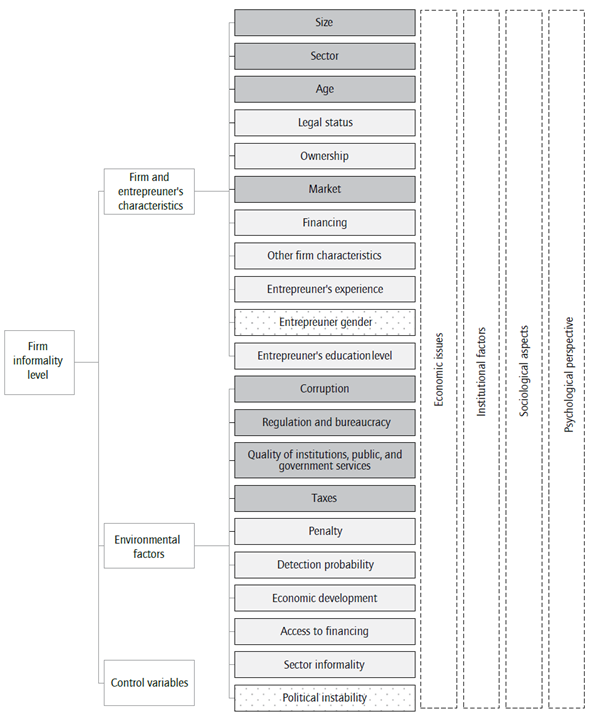
Source: authors.
Figure 2 Firm informality determinants: integral model. The shading of the cells represents the robustness of the empirical findings: dark grey factors have a greater degree of empirical evidence and light grey elements have been less studied. The boxes with dotted fill present contradictory empirical evidence.
Additionally, considering previous empirical evidence (tables 2 and 3), for certain determinant variables it is possible to outline the type of link with the informal sector. In that sense, business informality is expected to be positively associated with companies in the service sector, sole proprietorship legal status, private ownership structures, high tax burden, corruption, regulation and bureaucracy, sector informality, and political instability. In contrast, business informality is supposed to be negatively linked to firm size and age, foreign or state ownership structures, exporting companies, the use of external financing, certified financial statements or international quality certifications, entrepreneur's experience and education level, penalty, detection probability, public services, government and institutions quality, the level of economic development of a country, and access to financing.
Concluding remarks
This paper identified and organized the determinants of firm informality based on a systematic literature review of theoretical and empirical studies on informal economy and tax evasion. The analysis allowed us to recognize that the informal business sector comprises both unregistered and registered companies that underreport revenues. The review showed several types of methodological approaches to study the informal economy, with a prevalence of macroeconomic methods before the 2000s and a more recent tendency to use microdata, thanks to the information provided by the World Bank (2018). Moreover, the articles retrieved in the review are associated to a greater extent with the legalistic approach. This could be indicating a certain correlation between theoretical approaches and types of informality. In other words, firm informality is mostly addressed in the literature as a decision or voluntary choice by companies and entrepreneurs (legalistic vision). As for the determinants, there are many studies that examine the effect of certain environmental factors on informality, such as corruption, regulation and bureaucracy, public services and institutions quality, and taxes. Conversely, the other elements of the environment (penalty, detection probability, sector informality, political instability), as well as some company and entrepreneur's characteristics, have been less empirically studied.
The literature review was carried out in international academic databases and the selection criteria of the analyzed works were consistency with the object of study (firm informality), their relevance (number of citations), and date of publication (recent publications). Although such parameters allow obtaining current, relevant and impactful articles, they can also be considered a limitation given the geographic and focus bias of the selected databases. This restriction could be amended in future research studies by expanding the review with searches in Latin American bibliographic databases.
This study presented various academic and practical contributions. As a first academic contribution, we highlight the focus of the research, as we exclusively targeted firm informality, examining reasons that encourage corporate tax evasion -over personal tax evasion (Torgler, 2002)- and excluding the analysis of the unregistered employment causes (labor market informality). In this way, our review attempted to cover the gap identified by some authors. For example, according to Torgler (2011), "corporate tax evasion in general has received very little attention, therefore, work in this area is highly relevant" (p. 6). Similarly, Abdixhiku et al. (2018) and Nur-Tegin (2008) recognized that the lack of studies on corporate tax evasion is problematic, especially since in many countries most taxes are paid by companies and, at the same time, companies represent the highest share of tax evasion.
Second, we collected, synthesized and exposed the relevant aspects of an important set of studies on informality addressing different methodological approaches (macro and microeconomic), contexts (developed, emerging and transition countries), and periods (1983-2018). Specifically, we presented interesting general issues as main concepts and size estimating methods of the informal economy. In particular, we organized the existing research according to the methodological approach adopted and the definition of dependent variables, identified the determinants of business informality, and reported the link found by the empirical evidence between such factors and the informal sector.
In view of the research carried out, as a third contribution, we proposed an integral model according to which the level of business informality was determined by a series of structural elements (company and entrepreneur's characteristics), a group of environmental factors (corruption, regulation and bureaucracy, taxes, etc.), and a set of control variables. Besides identifying theoretical perspectives and methodological approaches, the suggested model summarizes the empirical findings of previous studies for each determinant factor. Therefore, the model becomes the starting point for potential empirical research on determinants of informality based on macroeconomic estimates or mi-crodata (primary or secondary) in different contexts, thus contributing to reduce the gap identified by the literature.
In conclusion, our analysis certainly provides useful insights on corporate informality or tax evasion, both for the research community and policymakers. There are at least five directions for further research emerging from this review. First, we expect the development of empirical studies about business informality determinants in less studied contexts or where the phenomenon is more common; for example, in emerging countries. Likewise, future works should deepen the analysis of determinants that have been less addressed by previous literature or of those factors whose link with informality seems to be ambiguous. As a third instance, future research studies could focus on analyzing which of the underlying theories have greater capacity to explain the determinants of business informality. In line with this, comparisons of the causes of the informal economy can be made among countries or regions with different institutional settings. The temporal evolution of the determinants could also be studied.
Among the practical contributions of this work, our review and synthesis of the empirical evidence is relevant for public policymakers because it allows identifying where efforts should be directed in order to reduce business informality. In that sense, the potential lines of solution can be organized into two groups. On the one hand, a series of control measures focused on business typologies with a greater propensity to underreporting. On the other, a second set of strategies with impact on the factors that directly intervene in the cost-benefit decision to underreport sales or in the environmental elements that influence the level of reported income.














